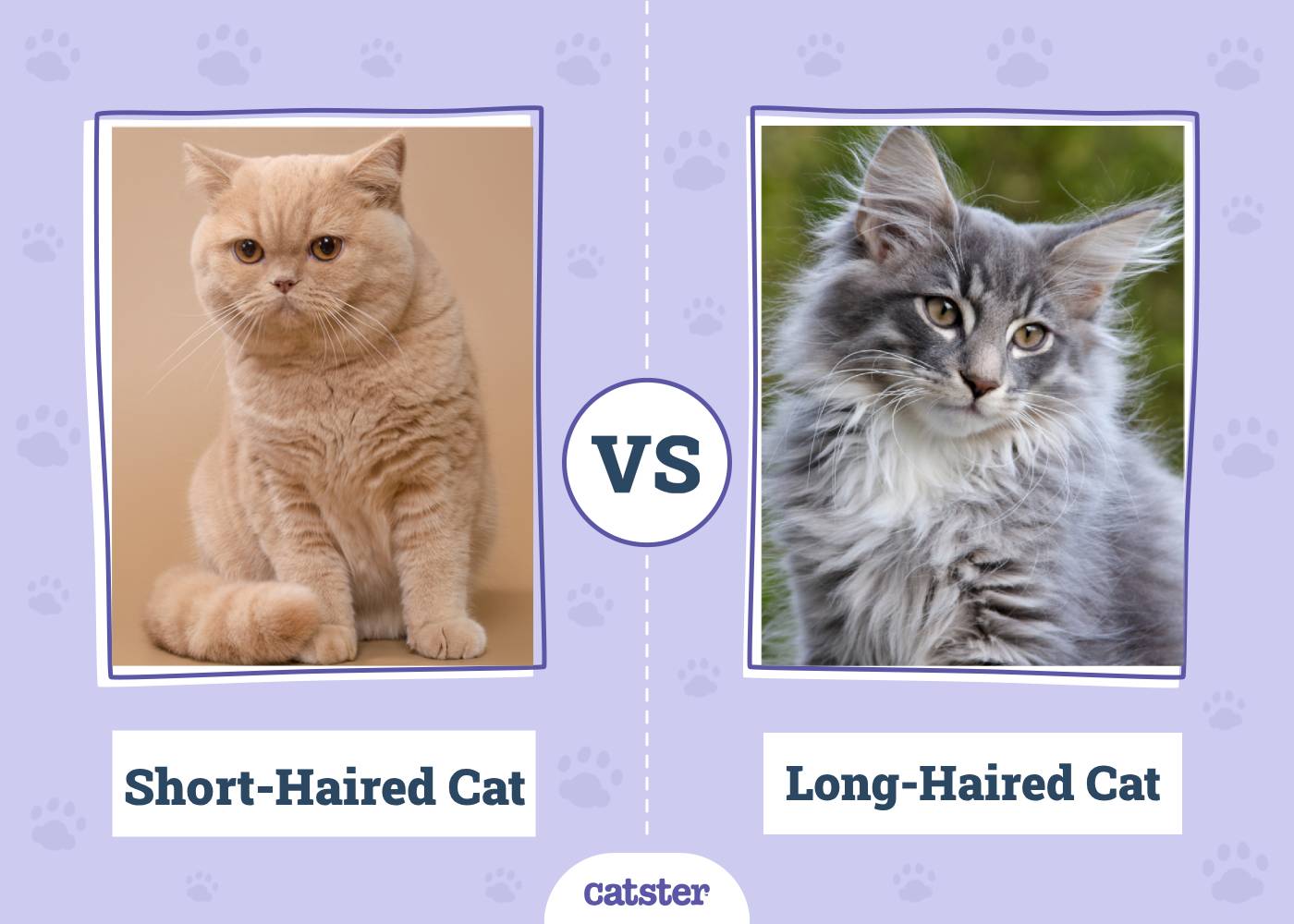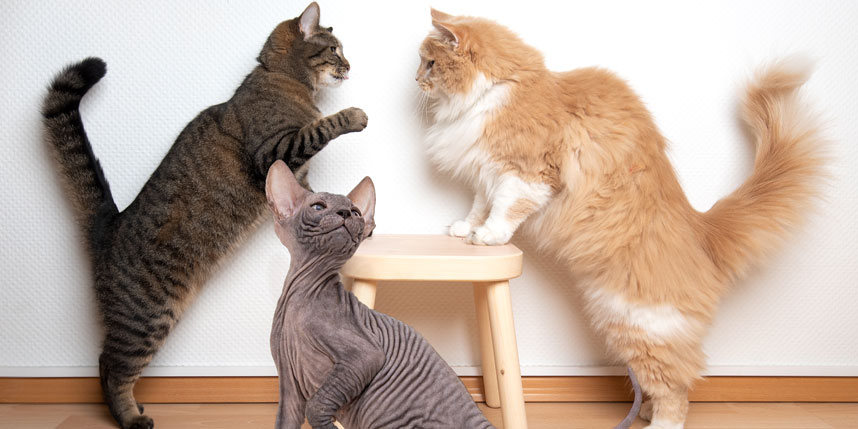Have you ever found yourself torn between the allure of a long-haired feline and the sleek elegance of a short-haired cat? With such a multitude of furry companions to choose from, it’s no wonder you might be unsure which type best suits your lifestyle and caregiving preferences.

A Tale of Fur: Long-Haired vs. Short-Haired Cats
When it comes to our furry friends, their coat length often becomes a defining feature. Long-haired cats like the Maine Coon or Persian are known for their luxurious, flowing locks, whereas short-haired breeds such as the American Shorthair offer a more streamlined appearance. This guide seeks to shed light—no pun intended—on the key differences that set these two categories apart.
History and Origins
The differences between long-haired and short-haired cats can be traced back to their origins. Long-haired cats typically hail from colder climates, which necessitate thicker, longer fur for warmth. Think of the Norwegian Forest Cat whose dense coat protected it from the frigid Scandinavian winters. Short-haired cats, on the other hand, are more commonly found in warmer regions where a lighter, shorter coat helps with heat dissipation and agility. For instance, the short-haired Abyssinian is believed to have roots in ancient Egypt.
Appearance: More Than Skin Deep
The visual difference between long-haired and short-haired cats is perhaps the most noticeable. Long-haired cats boast voluminous coats that can make them appear larger and add an almost regal air to their presence. Short-haired cats, in contrast, have a sleeker, more streamlined appearance, making them look agile and athletic.
| Feature | Long-Haired Cats | Short-Haired Cats |
|---|---|---|
| Coat Length | Long, flowing, and often dense | Short, sleek, and close to skin |
| Shedding Amount | Generally more, due to thicker coat | Usually less |
| Grooming Frequency | Daily to prevent tangles and mats | Weekly or bi-weekly |
Grooming Needs: A Labor of Love
If you’re considering a long-haired cat, be prepared for a grooming regimen that is quite the commitment. Daily brushing is essential to prevent mats and tangles, which can be uncomfortable for your cat and challenging to remove. On the other hand, short-haired cats require less frequent grooming—usually a good brush once a week will suffice. However, during shedding seasons, even short-haired breeds may benefit from more regular grooming to manage loose fur.
Brushing Tips
- For Long-Haired Cats: Use a wide-toothed comb followed by a slicker brush to remove tangles and reduce shedding.
- For Short-Haired Cats: A rubber grooming mitt or a fine-toothed comb can help manage loose hairs and provide a bit of a massage for your feline friend.
Shedding Cycles: Fur-tastrophes!
Let’s face it: cat owners learn to live with fur on their clothes, furniture, and just about everywhere else. Long-haired cats tend to shed more frequently and noticeably because their longer fur is more difficult to manage. Short-haired cats shed too, but the hair is less conspicuous and easier to clean up.
Personality: Does Fur Length Affect Temperament?
There’s an age-old debate among cat enthusiasts about whether a cat’s fur length influences its personality. While there’s no scientific evidence to firmly support this, anecdotal observations often highlight some trends:
- Long-Haired Cats: Many owners find them to be more laid-back and affectionate. Perhaps it’s the pampering grooming sessions that create these soft-hearted fluffballs.
- Short-Haired Cats: These tend to be described as more energetic and independent. Their low-maintenance grooming needs might align with stronger, self-reliant characteristics.
Health Considerations: Not Just Skin Deep
The type of fur a cat has can also impact its health in a few ways. Long-haired cats are more prone to hairballs, given the amount of fur they ingest while grooming. Regular brushing and special diets can help manage this issue. Short-haired cats generally have fewer hairballs, but they aren’t entirely exempt from them.
Fur-Reflecting Health
-
Healthy Fur: Whether your feline has long or short hair, their coat should be shiny and soft. A dull, brittle coat could signify underlying health issues, dietary deficiencies, or stress.
-
Regular Check-Ups: Routine veterinary check-ups are vital for both long-haired and short-haired cats to ensure they remain in tip-top health.
Environmental Impact: From Fur to Foot
Owning a cat, long-haired or short-haired, translates into some lifestyle adjustments. If you’re meticulous about a fur-free home, both cat types will challenge your cleaning prowess—though long-haired cats might test it a little more.
- Long-Haired Cats: Expect more fur around the house, necessitating frequent vacuuming and lint-rolling. Their longer fur can also trap dirt and debris more easily, which requires closer attention.
- Short-Haired Cats: Easier to maintain, but during shedding seasons, you might still find tufts of fur clinging to your favorite chair.
Adaptability: Flexibility in Fur
Having a furry companion means accommodating their needs into your lifestyle, and different fur types come with unique challenges and rewards.
-
Home Environment: Long-haired cats might fare better in environments where they can roam freely without their fur becoming a nuisance. Short-haired cats are versatile pets that adapt well to both small apartments and larger homes.
-
Travel: If you travel often, a short-haired cat may be easier to manage due to its minimal grooming needs. However, long-haired cats might appreciate the extra bonding time that comes with daily grooming sessions if you’re home frequently.
Emotional Bonding: Fur-ever Friends
The grooming routine of a long-haired cat can deepen the bond between you and your pet. Those daily sessions become a time of connection and care. Short-haired cats won’t demand as much grooming time, but they still enjoy and benefit from regular petting and brushing sessions.
Special Breeds: Unique Feline Choices
Some breeds stand out in both the long-haired and short-haired categories due to their distinctive characteristics.
Magnificent Long-Haired Breeds
- Maine Coon: Known for its tufted ears and bushy tail, this is the gentle giant of the cat world.
- Persian: With its flat face and luxurious coat, the Persian is a true emblem of feline elegance.
- Ragdoll: Ragdolls live up to their name, often going limp when held. They’re known for their striking blue eyes and semi-long fur.
Wonderful Short-Haired Breeds
- Abyssinian: Sleek and active, these cats are often likened to miniature cougars in their sleek appearance and playful demeanor.
- British Shorthair: With its dense, plush coat and round face, this breed is both charming and relatively low-maintenance in the grooming department.
- Siamese: Renowned for their striking blue eyes, color points, and vocal nature, Siamese cats are as social as they are beautiful.
Allergenic Aspects: Sniffles and Sneezes
One of the most critical factors if you have allergies is whether a cat will exacerbate your symptoms. While no cat is truly hypoallergenic, some might be more manageable for allergy sufferers.
- Long-Haired Cats: Usually produce more dander due to their extensive grooming, which can aggravate allergies.
- Short-Haired Cats: Often preferred for those with mild allergies; they generally produce less dander and shed less than their long-haired counterparts.
Practical Side: Household Harmony
Living with a furry companion, regardless of coat length, requires some practical considerations to ensure both you and your cat live harmoniously.
- Fur Control: Investing in good quality vacuum cleaners, lint brushes, and washable furniture covers can make a significant difference.
- Diet and Nutrition: A well-balanced diet contributes to a healthy coat. Long-haired cats may benefit from diets designed to control hairballs, whereas short-haired cats may not need these specialized foods.
Outdoor Adventures vs. Indoor Life
Deciding whether your cat will be an indoor or outdoor pet is another critical choice influenced by their fur type.
- Long-Haired Cats: Often better suited to indoor living where their coats won’t become matted with leaves and debris.
- Short-Haired Cats: More versatile in this regard; their sleek coats are easier to maintain even if they enjoy occasional outdoor adventures.
Fun Facts: Fur-tastic Trivia
Did you know that a cat’s fur can change colors? For example, some temperature-sensitive breeds like the Siamese experience a darker coat in cooler climates. Or that all cats shed their coats twice a year, adapting to seasonal changes?
Bonding Time: More than Just Brushing
Fur maintenance isn’t merely about keeping your home clean and your pet healthy; it’s also a valuable bonding experience. The tactile experience of grooming your cat, whether long or short-haired, provides a form of bonding and trust-building.
Final Thoughts: Which Cat is Right for You?
Choosing between a long-haired and a short-haired cat involves weighing various factors, from grooming commitments to lifestyle adjustments. Both types have their unique charms and requirements, and your decision should reflect what best fits not just your lifestyle but also how much time, effort, and care you’re willing to invest in maintaining their coat.
Summary: The Fur Wrap-Up
Caring for a long-haired cat is a labor of love that requires daily grooming and regular upkeep, while a short-haired cat offers a more low-maintenance approach but still needs routine care. Each type of cat brings its unique personality and set of needs, creating a mutually rewarding relationship when appropriately nurtured. Whether long or short-haired, your feline friend will undoubtedly add warmth, love, and furry joy to your life.

